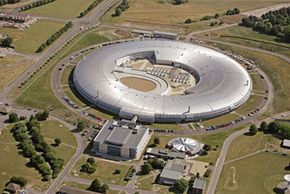By the numbers, the Diamond synchrotron facility in Oxfordshire, England, was a massive undertaking. The particle accelerator cost more than $500 million to build and is housed in a circular building equal in size to five soccer fields. It also produces a highly focused beam of light "10 billion times brighter than the Sun" [source: BBC News].
This incredibly powerful light source and the technological might behind it have many potential scientific applications. But it may surprise you that the Diamond synchrotron could produce its most important discoveries in the field of theology.
Advertisement
Scientists hope to use light from the Diamond synchrotron to "read" ancient texts that have suffered significant damage. Although the discovery of an ancient scroll or manuscript represents a major achievement for archaeologists, anthropologists and other researchers, frequently, these texts are too fragile to open or simply too faded or damaged to read. With the Diamond synchrotron, scientists hope to get around that problem -- this particle accelerator allows scientists to read some books without even opening them.
The synchrotron emits a powerful X-ray that, when applied to a scroll, allows scientists to produce a 3-D image of the text. With the aid of computer imaging software, scientists then separate the various layers of the image to reconstruct the pages of the book or scroll. In some cases, the text is then readable. The technique has already been successfully applied to texts written with iron gall ink, which scribes began using in the 12th century. Because these parchments contain iron from the ink, applying X-rays results in the formation of an absorption image, distinguishing traces of ink from parchment.
A similar technique has been used on parts of the Dead Sea Scrolls, which researchers were wary about, for fear of damaging them. Once the process of reading texts is improved, it could be used to read a variety of books and manuscripts that have, because of their poor condition, made deciphering their meaning difficult.
Many ancient texts are written on parchment made of dried animal skin. Over time, collagen in the parchment turns into gelatin, causing the parchment and text to deteriorate. Scientists can use the Diamond synchrotron to learn how much of a parchment's collagen has become gelatin and the parchment's level of decay. They also hope to develop new insights into how to preserve manuscripts and to recover those believed to have been lost to the effects of the environment and time.
The Diamond synchrotron's powerful light source emits many types of light, allowing researchers to produce images of objects on the atomic level. On the next page, we'll take a closer look at the technology behind the Diamond synchrotron and other synchrotrons. We'll also find out what else scientists hope to learn from the Diamond synchrotron.
Advertisement

